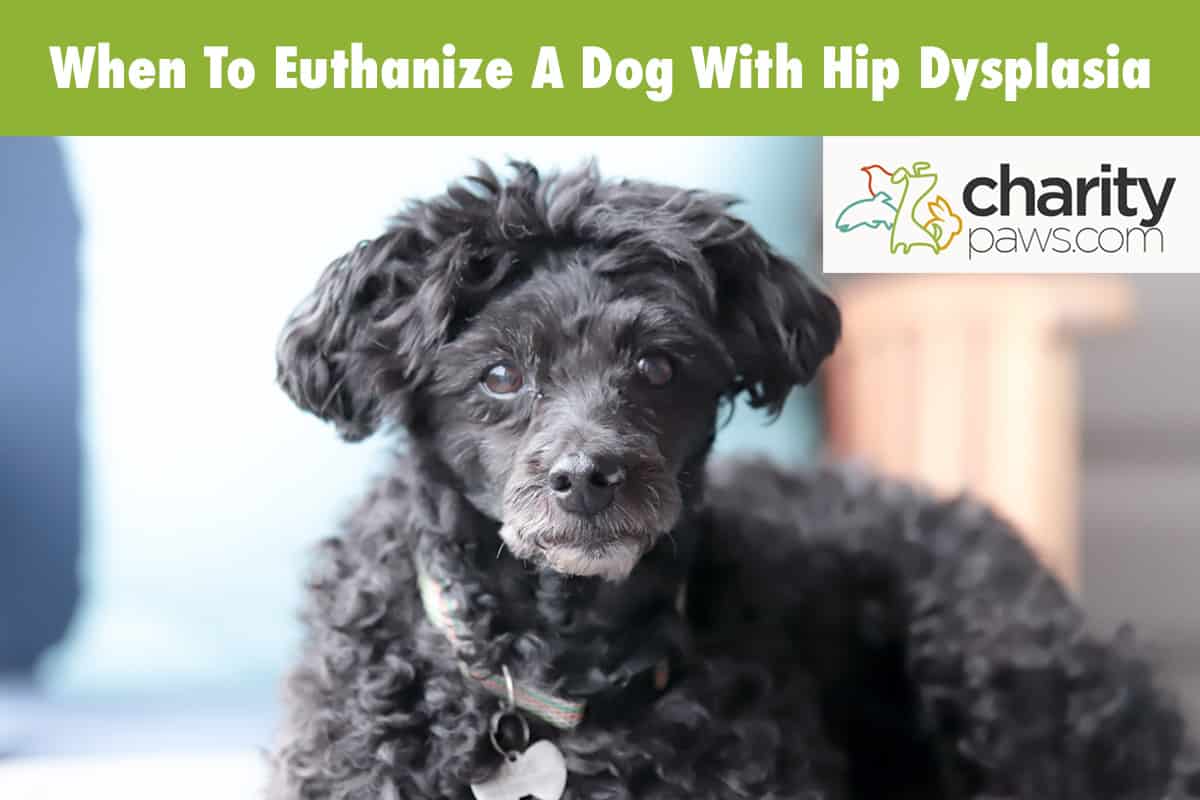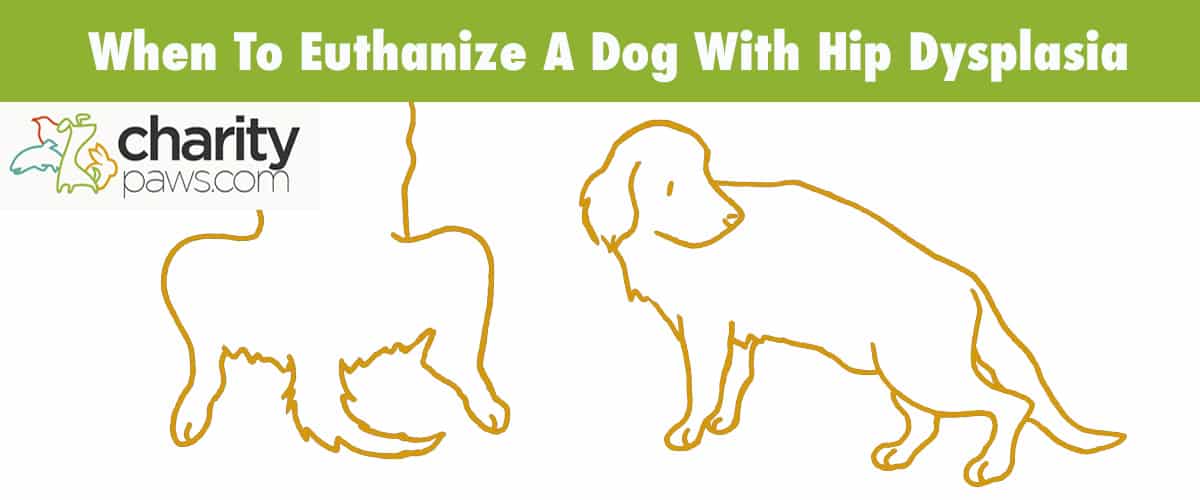The thought of our beloved companions being in pain is absolutely unbearable. A diagnosis of hip dysplasia in your dog can leave you heartbroken, often wondering if they are experiencing discomfort each day.
There are many ways to promote comfort and longevity in your dog with hip dysplasia, but there may come a time in which they are beginning to suffer.
To make sure you understand when it may be time to say goodbye to your dog with hip dysplasia, let’s discuss the details below.

What Is Hip Dysplasia In Dogs?
Hip dysplasia is a painful condition that impacts many canine friends. Hip dysplasia prevents the hip joint from moving smoothly with each step, leading to an inflammatory cycle to follow.
While a dog without the condition will have a healthy ball and socket joint that glides freely, a dog with hip dysplasia will have difficulties with this action.
When a dog has hip dysplasia, the improper development of the hip joint will lead to laxity in the area. The body will then attempt to stabilize the joint with the development of scar tissue and bony spurs, causing the hip joint to grind each time the dog takes a step.
Eventually, the cycle of inflammation will lead to the development of severe arthritis in the area, along with significant pain because of it.
The damage to the hips will only get worse and worse as time goes on if it is not managed properly, eventually leading to unbearable pain for the dog affected. Our dogs cannot avoid walking, so it becomes impossible for them to get away from the pain.
This is why many dogs are put to sleep because of their hip dysplasia.
With this condition impacting a dog’s range of motion and flexibility, the most common symptoms of the disease are related to mobility.
Some of the most common signs of hip dysplasia in dogs include:
- Joint stiffness, especially when they first wake up
- Limited flexibility or range of motion
- Difficulty getting up from a seated or lying position
- Difficulty getting up and down from furniture
- Limping, even occasional
- Muscle wasting in their hind end
- Change in their normal gait, often much more stiff than usual
- Swollen joints
- Sensitive to have their back legs touched
- Reluctance to climb stairs or jump on furniture
- Limb weakness
- Back end slipping or falling out from under them
- Shying away from physical activity
- Crying out when their back legs are touched
Now that you are aware of the ways in which hip dysplasia can impact your dog’s quality of life, let’s move on to other questions “when to euthanize your dog with hip dysplasia”.
Can A Dog Live A Normal Life With Hip Dysplasia?
Hip dysplasia in dogs is a serious diagnosis that needs to be managed closely, but many dogs can still live a full life for quite some time after their diagnosis. This of course varies based on how early on they are diagnosed, but it is by no means an instant death sentence.
For example, if your young dog was diagnosed with hip dysplasia due to some minor stiffness, there is a high likelihood that they can be managed well for multiple years to come.
By following the treatment plan your vet suggests, this pup can have a normal life with mild discomfort up until their senior years. You may even be able to prevent significant joint damage and pain in the future with a well rounded treatment plan.
However, if your dog is diagnosed with hip dysplasia late into adulthood due to symptoms of significant pain, it may be more challenging to manage.
If your dog has already sustained substantial damage to their hip joint, this is often more difficult to get on top of and manage their pain moving forward. Their quality of life may be impacted due to their discomfort, and they may not enjoy physical activities that they used to happily participate in.
How Long Can A Dog Live With Hip Dysplasia?
Hip dysplasia is not a fatal condition, so there is no general life expectancy to refer to.
When a pet owner is forced to euthanize their dog with hip dysplasia, this is typically due to their decreased quality of life because of their pain. If your dog’s hip dysplasia is managed from an early age, there is no reason to believe they will live any shorter of a life.
However, if your dog with hip dysplasia is diagnosed later on in life or is having severe pain, you may need to end their pain anywhere from 1-4 years earlier than they would have passed naturally. This is challenging to determine, as every situation will vary.
5 Treatment Options For Dogs With Hip Dysplasia?
Hip dysplasia in dogs cannot be cured completely, but it can certainly be managed long term.
There is a list of long term management options based on your dog’s case, so let’s list a few of the most common treatment options below.
Joint Supplements
Whether you have a dog that is prone to joint disease or a dog that has been diagnosed with hip dysplasia, joint supplements are a must.
Joint supplements typically offer a combination of anti-inflammatory substances, each of which help to target the destructive inflammation within the joints. By offering these supplements each day, you can help to prevent further joint destruction and manage discomfort long term.
Physical Therapy & Exercise
When a dog is diagnosed with hip dysplasia, there should always be some form of physical therapy in their routine.
Whether this is professional therapy or low impact exercise at home, this will help your dog combat any muscle loss as a result of their hip dysplasia. This can also help to alleviate any stiffness as a result of their condition, which in turn improves their range of motion moving forward.
Maintaining A Healthy Weight
If your dog has been diagnosed with any form of joint condition, it is essential to make sure they stay at a healthy weight.
Any excess amount of weight can put additional stress on your dog’s painful hips and joints, leading to further damage to the area as time goes on. Not only will preventing obesity help with managing hip dysplasia, but it can help to prevent an array of dangerous health complications as well.
Prescription Medications
If a dog is experiencing significant discomfort as a result of their hip dysplasia, your vet can prescribe medications that target their inflammation and pain.
This can either be a long term solution or a tool to handle flare ups, but it can be a wonderful option to explore with your veterinarian.
Surgical Treatment
There are two different surgical options that can be explored for dogs with hip dysplasia, one as a preventative tool for high risk pups and the other as a long term treatment method.
The preventative surgery is known as a juvenile pubic symphysiodesis, and it aims to make sure the hip joints grow into a normal position. This procedure is only successful when it is performed before 1 year of age, and it is a great solution for high risk puppies.
The second option is a femoral head ostectomy, and it involves removing the entire femoral head of the femur. This allows the vet to remove the damaged portion of the hip joint, and promotes pain free movement moving forward.
These options are typically only explored for severe or high risk situations, so we suggest asking your vet if your dog falls into either of these categories.
Are There At Home Treatment Options For Hip Dysplasia?
While your vet can offer a long term medical plan moving forward, there are many at home treatment methods that can improve your dog’s quality of life as well.
Ongoing at home care is essential for dogs with hip dysplasia, as this is what can help in making a significant impact in their everyday life.
Some of the best at home treatment options for dogs with hip dysplasia include:
- Low impact walking
- Restricting vigorous exercise
- Give them an orthopedic grade bed
- Adding rugs to slick surfaces
- Adding ramps to any furniture they like to rest on
- Raising their food and water bowls
- Help them avoid climbing stairs when possible
- Help them stretch a few times a week
Every case of hip dysplasia will vary, so we suggest asking your vet about any other suggestions they have for at home care.
Are There Exercises That Help A Dog With Hip Dysplasia?
As we mentioned above, physical therapy is a wonderful way to help a dog with hip dysplasia gain strength in their back end. The best form of therapy is low impact, high resistance exercise, and this can be found with a few easy to access options.
Some of the best forms of exercise for dogs with hip dysplasia include hydrotherapy (water therapy), low impact walking on grass or dirt trails, and daily range of motion exercises.
These options can not only improve your dog’s muscle strength in their back legs, but it will also help them maintain a healthy weight.
Can I Still Walk My Dog With Hip Dysplasia?
Low impact walks are actually recommended for dogs with hip dysplasia. High intensity exercise can aggregate a dog’s sore hips, but low impact exercises like walking can help them build strength in their weakened muscles.
Light walking can help a dog build up their hind leg strength, maintain a healthy body weight, and offer daily enrichment. Not only is the answer to this question yes, but it is even encouraged in managing their joint condition.
Will Hip Dysplasia Eventually Kill My Dog?
As we have discussed above, hip dysplasia itself is not fatal in dogs.
It can certainly progress to the point of a decreased quality of life, but it will not lead to a natural death for the dog affected. If your dog passes away as a result of their hip dysplasia, it will be because their family elected to put them to sleep and end their pain.
If A Dog Has Hip Dysplasia, Do You Have To Eventually Put Them Down?
While it certainly is possible that you will need to make that tough decision if they begin to suffer, it should not automatically be assumed. Some dogs can live full lives with a successful management plan and lifestyle changes, and may never experience suffering as a result of their hip dysplasia.
While it is something to keep in mind as you move forward with their diagnosis, it does not have to be the case.
When Should You Decide To Euthanize?
While we have discussed in detail that a hip dysplasia diagnosis in dogs is not an instant death sentence, there will be some dogs that struggle with the condition as the years go by. Some dogs will develop severe damage to the hip joints, leading to significant pain each day of their life.
This pain can deeply impact their quality of life, and make every aspect of their daily routine unbearable. If this is the case for your dog with hip dysplasia, we understand why you are considering saying goodbye.
We know it can be difficult to make that final decision to end your dog’s suffering, and you still may need a bit of guidance to help you get there.
Being aware of the signs of a dog suffering with their hip pain can be beneficial, so let’s list a few signs of end stage hip dysplasia in dogs below.
Your dog may be suffering with their daily pain if they are experiencing the following symptoms:
- They can no longer get up and down on their own
- They have severe muscle wasting on their back end
- They fall down often or are unsteady on their feet
- They experience severe stiffness that limits their movement capabilities
- They cry out when their back legs or hips are touched or manipulated
- Disinterest in activities they once enjoyed
- Crying or whimpering often
- Increased aggression or grumpiness
- Urinating or defecating on themselves or in their bedding because it hurts too much to get up
- Decreased appetite
- No longer getting excited about things that use to bring them happiness
While some of these dogs can still be helped with the addition of physical therapy or prescription pain control, we understand that sometimes relieving them of their pain is the kindest option.
Not every case of hip dysplasia can be treated effectively long term, so you shouldn’t feel guilty about considering euthanasia in these situations. If your dog is experiencing any of the above symptoms, or they are struggling with any other forms of health decline, it may be time to speak with your vet about saying goodbye.
Are There Other Factors When Deciding To Euthanize?
When you are making the decision to say goodbye to your dog with hip dysplasia, there are other factors to consider outside of their general health decline.
You know your dog better than anyone, so if you feel like they are having more bad days than good for any other reason, then euthanasia is likely the best decision.
We urge you to ask yourself a few questions to gauge their quality of life and future outlook such as:
- Do they have any other medical conditions that are impacting their health?
- Have you tried other options to relieve their pain, only to keep ending up here?
- Are you having to help them with normal tasks such as getting up and down, going outside, going up stairs, etc.?
- Does it seem like they still enjoy their favorite activities or items?
- Does it seem like you have lost the pup you once knew?
If any of these questions lead you to believe that your dog is suffering, then saying goodbye to your beloved pup can be the purest form of love you can offer at this point.
If you are still unsure about what is best for your dog at this point, you can always speak with your vet about your current concerns.
Final Thoughts On When To Put Your Dog Down With Hip Dysplasia

Due to the significant joint damage hip dysplasia can cause in dogs, many pups will reach the point of suffering in their senior years.
Just because your dog has hip dysplasia, does not mean you have to immediately start thinking about when to put them down. Dog with this condition can live long happy lives.
When you notice your dog in pain and their quality of life is no longer there, that is when you should start looking at when to euthanize.
We urge you to speak with your vet about what your dog’s prognosis is with ongoing care, and always seek their guidance if you think it may be time to say goodbye.
Resources:
1.) https://pubmed.ncbi.nlm.nih.gov/28576272/
2.) https://vcahospitals.com/know-your-pet/femoral-head-ostectomy-fho-in-dogs

